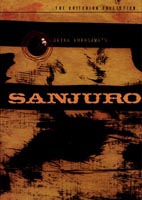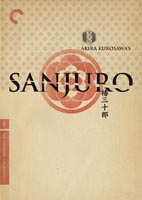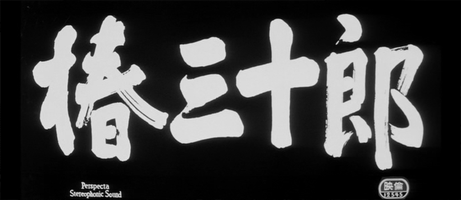1999:  2007:
2007: 

directed by Akira Kurosawa
screenplay by Ryuzo Kikushima, Hideo Oguni and Akira Kurosawa
based on the book 日々平安 (Peaceful Days) (1958) by Shugoro Yamamoto
Criterion #53. Sequel me!
椿三十郎 = Tsubaki Sanjūrō = “Thirty-Year-Old Camellia.” The international title is Sanjuro. So basically this movie is called Thirtysomething. (I have just checked whether there is a Japanese-language version of the Wikipedia page for Thirtysomething, to compare the titles. There is not.)
But why, really, is it called “Thirty-Year-Old Camellia”? Well, when our mysterious hero is asked his name in Yojimbo, he resorts to the old “at the Alamo in the basement” routine: he looks out the window, sees a mulberry field, and says his name is “Kuwabatake Sanjuro (= thirty-year-old mulberry-field)… though actually I’m nearly forty.” The sequel repeats the whole bit, except this time there are camellias out the window.
It’s all about the mythic force of the ritualistic running gag. “Bond. James Bond.” Aw yeeah, he said the thing he always says! Kickass! As the orphan in The Cider House Rules explains, when another orphan asks why Michael Caine always recites the same little benediction every night when he turns out the light: “He does it because we like it.” Just like James Bond! Just like getting tucked in at night! The difference between “kickass” and “snuggly-cozy” is only a very slender line of macho denial.
This is only the second movie about “Thirty-Year-Old. Thirty-Year-Old [Plant-Out-The-Window],” which might seem a little premature for selling snuggly-coziness, but that’s what Sanjuro is selling. And I think that’s why I liked it better than Yojimbo. Because I know this game and I know how to play along. Tuck, tuck me in!
This movie doesn’t just happen to be one of the sources of that iconic image of Toshiro Mifune as a samurai (you know, the famous image, the one from CULTURE AT LARGE); this movie is itself deliberately trading on that iconicity, amping it up to make sure we get what we came for and know that we got it. Look at him go! it says. Look, it’s really him! It’s really one of those movies, and it’s happening right now! You are watching a sequel! Unlike Yojimbo, this one never feels less than commercial.
Well, that’s great. I’m all for it. Let’s hurry up and get this genre all good and coded out so that I don’t have to think about it rationally anymore. Because that’s really what I hate about samurai movies, westerns, and superhero movies: the pretense to actual representational meaning. As if! Enough already! The more artificial the better. If I’m going to have to watch samurai, I want you to put them through a rock tumbler first and make them all shiny. Comic book here we come! Bring on the magic powers! Bring on the time travel!
You think I’m kidding, but we really get almost all the way there. Sanjuro ends with a ridiculous duel — and by ridiculous I mean ridiculously KICKASS! — and by ridiculously KICKASS! I mean ridiculous — in which the two guys have a face-to-face epic comic-book stare-off for a very long time without moving, and then suddenly in a flash they both move and Toshiro Mifune has already killed the other guy, with a single slice across the chest that produces a truly fantastical fountain of spewing blood, like a firehose, Monty Python-style. In the bonus documentary we learn that the absurd overkill of this effect was a technical mishap, but that Kurosawa just went with it.
In other words, snuggly-cozy comic-book dream ballet for all the kids out there. The kids who can handle it.
Yojimbo felt pretty awkward for a classic made by people. Sanjuro feels pretty graceful for junk made by the system. I’ll take graceful junk over awkward classics any day. In fact I’ll take graceful junk over most things. (Junk of course is relative. Obviously there are limits. But this is 1962 and there’s still plenty of breathing room.)
I know, my response to Yojimbo was just a response to my own false expectations. Probably I should have just enjoyed it as good junk. I wish I could come to every movie purified of all prior knowledge of it, but I can’t.
Plot: Toshiro Mifune and the nine dumb good guys. “Do I have to do everything around here?” “I’m getting sick of your blundering!” “Now see what you’ve done!”
The story is about two officials, one of whom is bad and the other of whom is good. These two officials are a chamberlain and a superintendent. I couldn’t have come up with more MacGuffiny titles if I had tried. I find this aspect of the movie deeply charming. To a true innocent, everything in every movie is a MacGuffin. The “real purpose” is always outside the frame; what we are shown is only and ever an interplay of ciphers. Having to consider whether to trust the chamberlain or the superintendent brought me back to a time in my life before definitions. The movie operates there. Nine dumb guys and a smart guy have to rescue a kidnapped chamberlain from a superintendent and his army. Surreality is never far away.
The same might be said of that staple of childhood cinema, Star Wars, in which 70% of the dialogue is blessedly abstract. In Sanjuro once again I felt like I was seeing the complete contents of George Lucas’s brain laid out for inventory.
As my attitude toward life has been improving, my completist masochism has inevitably waned. I watched the documentary for real, but the commentary… well, it’s playing in the next room. Right now, as I type this. I can totally hear it. Here, right now he’s saying “…and that will give us the transition to this splendid sequence of Mifune stalking toward Muroto’s gate…” See?
It’s the same guy as last time, so I feel pretty sure I know how much he has to offer me. Now he’s saying: “… So you could say that one side of Sanjuro’s deadly nature, here, is his facial hair…” And now: “… Kurosawa almost never does this kind of routine continuity editing…” You get the drift. I know I do.
I promise not to post this until he’s done talking.
Music is by Masaru Sato again, with some use of the theme from Yojimbo and some of the same instrumentation, but generally a more restrained and sober dramatic approach. (With a couple of exuberant transgressions.) The score is more effective, less entertaining than last time around. Here’s the main title, all groaning and clattering. I like it. Sure sounds like this one’s gonna be bleaker than Yojimbo, doesn’t it? Well, turns out it isn’t. But too much atmosphere never hurt a movie.
He finished.
I had to read this several times to make out whether the brand of shampoo I bought in Tokyo is Camelia or Thirtysomething, either of which would be fitting, in my opinion. Hoping my three bottles of Tsubaki make it tsubaki to the U.S. intact.
I will have to watch these two films and see if they make all kinds of sense to me now.
Enjoyed the posts very much from 8000 miles away.